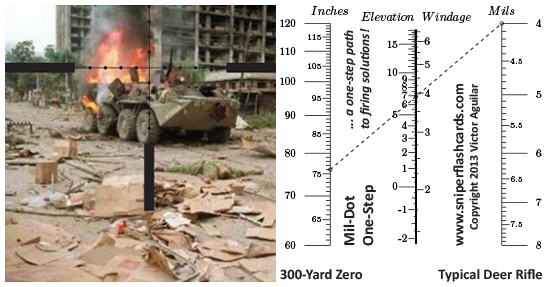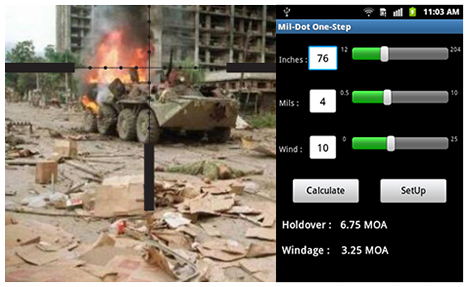In 2005 I introduced my Sniper Flash Cards, which are really a zero-step path to firing solutions. They help one memorize holdover and windage information so no steps are needed, which is a great help if you are aiming for a Kord gunner who is actively trying to kill you. This is really the wrong time to put your rifle down to dink around with a slide rule. If one has trained relentlessly with Sniper Flash Cards, it is possible to just reach up with one’s right hand, dial in windage and then hold on the appropriate mil-dot and fire without ever taking one’s eyes off the target – all in about five seconds.
This is vastly faster than using a slide rule. However, Sniper Flash Cards do not compete directly against the Mildot Master because they are only for objects of certain sizes, while the Mildot Master can range objects of arbitrary sizes. Also, Sniper Flash Cards are calibrated for a typical deer rifle and, while people often have inflated ideas about just how special their rifle’s ballistics are, it is still true that there is some round-off error in using the same system for everything from a .25-06 to a .308 rifle.
Most foreign snipers operate alone, but for snipers operating in two-person teams as U.S. snipers typically do, or for crew-served weapons such as the Ma Deuce, I now have a product that competes directly against the Mildot Master, beating it soundly at both accuracy and speed: The Mil-Dot One-Step!
Android Application now Available for Scopes with MOA or Mil Dials!

New 3.5x3.5" size, fits in your hip pocket! (8.5x11" available on request.)
Instructions: Hold your straight edge on the graph so it goes from 76" on the left-hand scale to 4 mils on the right-hand scale. Read the elevation off the left side of the middle scale; 67∕8 MOA. Read the windage adjustment for a 10 mph wind off the right side of the middle scale; 37∕8 MOA. Learn to read the wind in 5 mph increments, or 21∕2 mph increments if you are an expert, and mentally scale the reported windage adjustment up or down. For instance, the adjustment for a 5 mph wind would be 2 MOA and, for a 15 mph wind, 57∕8 MOA. This should take about five seconds if you have a helper to operate the Mil-Dot One-Step while you keep your eye on the target and adjust your scope’s dials as he instructs you to. I challenge anybody with a MilDot Master to replicate this calculation for both holdover and windage in under a minute.
The Mil-Dot One-Step can be custom made for any rifle, heavy machine gun or cannon. The typical deer rifle Mil-Dot One-Step shown above is suitable for deer hunters who wish to obtain the ability to engage in urban combat with the rifle and ammunition they already have. For more dedicated military or police snipers, I have the following Mil-Dot One-Steps available:
- Rifles zeroed at 100 yards, as is typical of police snipers:
- .223 Rem. 69-Grain OTM
- .308 Win. 168-Grain OTM
- Rifles zeroed at 300 meters, as is typical of international snipers:
- .308 Win. 168-Grain OTM
- .308 Win. 175-Grain OTM
- Rifles zeroed at 300 yards, as is typical of designated marksmen:
- .223 Rem.77-Grain OTM
- 6.5x55 Swedish 123-Grain OTM
- .260 Rem. 142-Grain OTM
- .308 Win. 168-Grain OTM
- .308 Win. 175-Grain OTM
- .30-06 Spring. 168-Grain OTM
- .300 Win. Mag. 190-Grain OTM
- .338 Lapua 250-Grain OTM
- .338 Lapua 300-Grain OTM
- Rifles zeroed at 300 yards that use hunting ammunition:
- .270 Win. 140-Grain Accubond
- .270 WSM. 140-Grain Accubond
- 7mm Rem. Mag. 160-Grain Accubond
- .30-06 Spring. 180-Grain Accubond
- .300 Win. Mag. 180-Grain Accubond
- .300 WSM. 180-Grain Accubond
- .338 Win. Mag. 180-Grain Accubond
- Typical Deer Rifle
- Rifles zeroed at 1000 yards, as is typical of long-range snipers:
- .338 Lapua 300-Grain OTM
The Mil-Dot One-Steps for police snipers have information on the back for firing at a 15° grade – military snipers never get on the roof of buildings like that. Here is why. The Mil-Dot One-Steps for designated marksmen are for measuring objects from 15” to 120” at ranges out to 800 yards. The Mil-Dot One-Steps for long-range snipers are for measuring objects from 60” to 180” at ranges out to 2500 yards.
Observe that a firing solution is reached in exactly one step. The user simply places a straight-edge on the graph between the size of the object in inches on the left-hand scale and the number of milliradians it subtends on the right-hand scale and then reads the correct holdover in MOA off the middle scale. A clear plastic strip like a large book mark is included with the Mil-Dot One-Step to use as a straight edge. It works well because it is transparent and one can see the graph through it, though one may use a machete or any other object with a straight edge.
The adjustment for a 10 mph crosswind can be read off the same scale. For a 5 mph wind, one would halve the reported adjustment and, for a 15 mph wind, one would add half again. Once one has learned to read the wind in 5 mph or 2½ mph increments, it only takes a few seconds to adjust one’s scope for windage. This is a great help for match shooters who are trained to read the wind at 600 yards but are at a loss on how to adjust their scope at arbitrary distances. The Mildot Master provides no help whatsoever with windage. A man is six feet tall but only one foot wide, so it is much more important to get windage correct, and that is exactly where the Mildot Master leaves the shooter helpless.
Compare the Mil-Dot One-Step to the complicated five-step procedure needed to operate a slide rule. They call it three steps but conceal four by describing two distinct steps separated by the word “and.” Worse, they omit mention of a very difficult fifth step, the mental interpolation of drop data, by conveniently and suspiciously giving only examples of targets at exact integer multiples of 100 yards. How devious Bruce Robinson is! Has nobody noticed that his slide rule works like shit for targets at arbitrary distances? Unless you are planning on texting the BTR-80 driver to ask him to kindly re-position his vehicle at an exact multiple of 100 yards before you shoot him, I suggest that you learn how to range targets at arbitrary distances.
I challenge anybody who currently owns a Mildot Master and operates in a two-man team to duplicate the above calculation for a 15-mph wind. Time oneself with a stop watch. With the Mil-Dot One-Step, the shooter can hold his sights on the target while his partner takes five seconds to position his straight edge on the graph and report the holdover and windage to within the nearest eighth of an MOA. It takes another five seconds for the shooter to reach up with his right hand, twist his dials, return his hand to the trigger and… Bang!!! Thus, with the Mil-Dot One-Step, it takes a total of ten seconds from when an enemy soldier is spotted to when your sniper team grants him martyrdom. A sniper team with a Mildot Master would take at least two minutes to calculate holdover, could not get it to within the nearest eighth MOA and would be at a complete loss for windage information. Pathetic!

